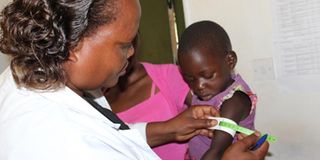MALNUTRITION IS STILL A LEADING CAUSE OF ILLNESS

A child being screened for malnourishment. File photo
What you need to know:
Malnutrition is one of the leading causes of ill-health among children. David Mafabi and Beatrice Nakibuuka explore the interventions made to reverse the trend.
Maimuna Katooko sits on a mat at her veranda, all her attention turned to her son whom she is holding on her lap.
The child, who is seated motionless, looks emaciated; with pale and wrinkled skin, sunken eyes and scanty hair that bears a golden brown hue.
The six-year-old boy now looks like a two-year-old and has a stiff gait, protruding belly and rusty-coloured hair that shows you all is not well.
Katooko, who hails from Hangaraba village in Himutu sub-county in Butaleja district, is one of the many mothers whose children suffer from severe malnutrition.
Her son looks wasted and when he cries, his voice is faint.
“He is so sick; when I last weighed him, he was about six kilogrammes and at times we feel he is going to die anytime. I have little hope that he will survive,” Katooko says.
When Daily Monitor arrives at this home, Katooko looks exhausted and Mudaha her fifth child crawls into her lap.
“I have taken Mudaha to all the health clinics, but he still looks like this,” she says in despair. “I don’t know what to do anymore.”
The family only eats once a day. Katooko and then children have a meal of rice or millet bread and greens at about 3pm.
Dr John Matovu, the District Health Officer says local reports indicate that most families resort to foraging for anything edible such as roots, leaves and wild rats to supplement porridge during the dry seasons
Burdened with countless household chores, including cooking, fetching water and firewood, and foraging for extra food, mothers such as Katooko find it difficult to attend properly to the needs of sick children. She has six children; all aged less than 12 years.
“And this explains why one out of every four families in Butaleja have a child who is malnourished. Mudaha represents one out of every three children in Uganda who are stunted,” says Dr Matovu.
Cost of malnutrition
According to findings of a wider study titled “The Cost of Hunger in Africa”, conducted by the Uganda government with the support of the World Food Programme, African Union Commission and other partners dated June 18, in the education sector, the report estimates that over 134,000 school year repetitions costing more than $9.5 million are associated with child under-nutrition.
“The situation is more pathetic when we talk about the school dropouts and those that study on empty stomachs and in the health sector, malnutrition costs Uganda an estimated $25 million in treatment of preventable diseases,” reads the report in part.
The study reveals further that 82 per cent of the cases of child undernutrition are not addressed and that this translates into an adult population of at least 54 per cent which has suffered from stunting as children with signs of cognitive delays while growing up.
Brenda Namugumya, Senior Technical Officer-Nutrition from Food and Nutrition Technical Assistance (FANTA II) project says although households have made strides in overcoming under nutrition by having kitchen gardens, it still remains a multi-sectoral challenge.
She revealed that as food shortages start to affect parts of Uganda, it is the youngest who suffer most.
Namugumya says research has shown that 12 per cent of women in reproductive age are too thin (BMI of less than 18.5 kg/m2), 23 per cent women of reproductive age have anaemia (less than 12.0g/dl) and that three in ten pregnant women have anaemia that impacts on the 438 maternal deaths per 100,000 live births.
Dr Elizabeth Madraa, the Fortification/Policy Advisor at Strengthening Partnerships, Results and Innovations in Nutrition Globally (SPRING) Uganda says malnutrition affects children under the age of five in whom growth is fast and beyond which age, some of the nutrition interventions cannot work.
Case for fortified food supplements
Dr Madraa says without the food and nutrients many children’s condition will not improve and that our local health facilities should be empowered to start the therapeutic feeding programme for children who are malnourished to receive special nutrition supplies.
She says fortified foods are crucial in addressing the problem of malnutrition, which remains a big burden in Uganda and urged the government to assist middle and small scale farmers to fortify their products.
Dr Madraa explains that while fortification is one of the most cost effective and sustainable approaches to addressing micronutrient malnutrition, it should be implemented alongside other strategies including bio-fortification and supplementation.
“Consumption of fortified foods is meant to improve nutritional status and to decrease the degree of malnutrition and prevent micronutrient deficiencies,” says Dr Madraa.
The Cost of Hunger Report 2013 released by World Food Programme and National Planning Authority indicates that 47 per cent of child deaths in the country are associated with malnutrition.
According to Boaz Musiimenta, head of nutrition department in the Prime Minister’s office, available w statistics indicate that 45 per cent of children in Karamoja are affected by malnutrition while in the western region it stands at 44 per cent.
Musiimenta says that the community needs to be enlightened on food security in their homes if the problem is to be reduced countrywide.
“It is not that people lack food but they are ignorant of the right food combinations,” says Musiimenta.
Health is not made at the hospital, it begins at home. During home visits in Ishaka District, we encountered a family with an old woman in her 80’s and nine children; three of whom were below five years and whose parents were not home. At about 1pm, there was no sign of food being prepared because the family members had just left the garden. The children’s mother had taken one of the twins (the youngest) to hospital.
The village health team member, Agaba Jacinta, recalled an earlier visit when they discovered the nine-month-old twin babies who could not sit, indicating that the were malnourished.
“Parents work so hard in the gardens and do not find time to feed their children. For breakfast, they only eat cold food they prepare in the evening,” says Agaba. This is the major cause of malnutrition here,” reveals the village health team member.
Although Uganda has made tremendous strides in reducing poverty, malnutrition in children, expectant and lactating mothers still remains one of the biggest public problems contributing to 45 per cent of the total infant deaths in the country according to USAID.
Malnutrition is a public health issue where one takes in more or less of the nutrients required by the body and it takes the forms as over or under nutrition.
The conditions for over nutrition include being overweight and obesity which is a common problem in majority of children from rich families. Under nutrition on the other hand takes the forms as chronic malnutrition where a child is too short for his age, underweight where a child has a low weight for their age, acute malnutrition where one has low weight for their height, low birth weight, anaemia, Vitamin A and iodine deficiency.
According to Dr Lynneth Turyagyenda, a nutritionist at the Mwanamugimu Nutrition Unit in Mulago hospital, there is a peak season when the unit receives more malnourished children than usual and this applies to children from both rich and poor families.
“The rainy season is our peak season. We receive an average of 30 children monthly but when it rains, the number increases to 50 yet we only have 30 beds at the unit. Since they come with severe malnutrition, we cannot send them away, so they sleep on the floor,” says Dr Turyagyenda.
Use of fortified foods in cases of severe malnutrition
According to Dr Mansur Toko, a nutritionist at Jinja Regional Referral Hospital says, it has been hard to treat malnourished children due to the community misconception where people refer to the condition as the disease of the lake or witchcraft.
Owing to this, he says, “There is poor health-seeking behaviour among the people and the situation is worsened by lack of family planning where mothers do not get enough time to care for one child because they get pregnant again.
Dr Elizabeth Madraa, a fortification and policy advisor SPRING Uganda notes that with the new government policy to fortify staple foods in the country, the use of Ready to Use Therapeutic Foods (RUTFs) is the way to curb severe and acute malnutrition in Uganda.
Food fortification would according to Dr Madraa help prevent and control diseases caused by micro-nutrient deficiencies. All fortified foods have an F logo on their packages and they include wheat and maize flour, cooking oils and fats with Vitamins A, B1, B2, B6, B12, iron, zinc, folic acid, zinc minerals.
Dr Madraa says, “RUTFs are special foods manufactured for nutritional therapeutic purposes. They are high energy foods that correct problems of severe and acute malnutrition among children.”
In some cases of malnutrition, children are at the point of starvation and their heart muscles are too weak to take in high energy dense foods because the heart will require a lot of energy to pump blood to help in the absorption of the nutrients. This may in turn cause stroke and sometimes death.
Cases of this nature once diagnosed are referred to nutrition centres where they get therapeutic feeds free of charge.
Doctors warn that when a child is started on the therapeutic feeds, they are not supposed to eat anything else in order not to overwhelm the body with too many nutrients.
When the child regains their appetite, the doctor will upgrade the feeds to F-100 and this may be after three days. With F-100 feeds, a 200g daily weight gain is expected and the child’s weight is measured daily.
When a child has no infections or complications and has gained his appetite, they are given the RUTF which are in peanut form and discharged from hospital.
Signs of malnutrition
Malnourished children usually lose muscles and their body fat wastes away. They will also get hair loss and darkened skin tone, become apathetic, lying without moving or crying for long periods of time.
The child may develop a swollen stomach, brittle hair. A child with kwashiorkor may seem healthy due to excess water accumulation in the body and will have a round, full look. The child will also be apathetic and tired.
Improper care and feeding for both expectant and lactating mothers also affects their nutrition status as well as that of the baby.
“A malnourished mother will give birth to a malnourished and low birth weight baby and if no intervention is made to educate the mother on how to feed, the problem can never be solved,” says Lynneth Turyagyenda a nutritionist and public health specialist at Mwanamugimu Nutritional unit in Mulago hospital.
She further remarks that mothers should breastfeed their babies exclusively for six months and continue breast feeding them until they turn two years with appropriate complementary feeding.
Brenda Namugumya, a nutritionist at Food and Nutrition Technical Assistance (FANTA) notes that most people in the villages have enough space to grow the crops on which they should be feeding to curb the problem but they sell all their produce and end up starving. This is the major cause of malnutrition in rural areas.


